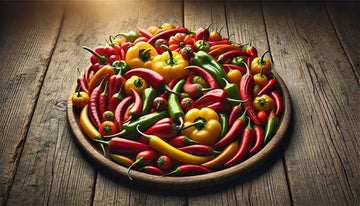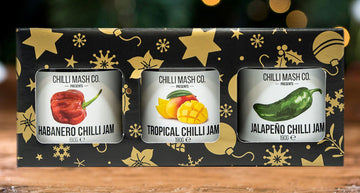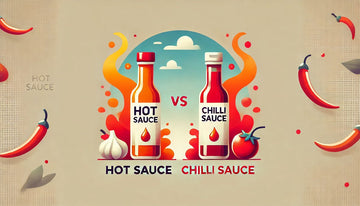Why Humans Are Drawn to Chilli: An Exploration of History, Science, and Sensory Appreciation
par {{ author }} The Chilli Guru au Oct 29, 2024

Chilli, characterized by its vibrant hues and stimulating heat, has garnered human interest and culinary application for millennia. Its widespread appeal, originating from the Indigenous regions of Central and South America to its contemporary status as a favoured ingredient globally, creates a common bond through a shared enthusiasm for this piquant fruit. This document examines the reasons behind humanity's affinity for chilli, delineating its historical journey and exploring its pervasive cultural relevance.
The Historical Roots of Chilli: A Millennia-Long Voyage
The narrative of chilli commences thousands of years ago in the Americas. Archaeological findings suggest that chilli peppers were domesticated approximately 7,500 years ago by indigenous groups in present-day Mexico, Peru, and Bolivia. These early agriculturalists recognized the plant's intriguing heat as a flavour enhancer and a natural preservative. Civilizations such as the Aztecs and Mayans incorporated chilli into their diets and spiritual practices, acknowledging its medicinal applications for various respiratory and digestive ailments.
The global dissemination of chilli commenced with Christopher Columbus's expedition to the Americas in 1492. In his pursuit of black pepper, Columbus encountered chillies, which soon found their way back to Europe. Chilli rapidly spread along trade routes to Africa, the Middle East, Asia, and other regions. Diverse cultures quickly adopted this dynamic ingredient, modifying it to resonate with local culinary traditions and birthing distinctive dishes that solidified chilli's status as a global culinary staple.
Explaining the Affinity for Chilli: Scientific Insights into Sensation
1. The Chemistry of Heat: Capsaicin and the Associated Euphoria
The allure of chilli can be attributed to capsaicin, the active compound responsible for the pepper's distinctive heat. Capsaicin interacts with TRPV1 receptors in the oral cavity, typically activated by high temperatures. The sensation of heat experienced while consuming chilli is not due to actual thermal injury; rather, it embodies a biological "misinterpretation" experienced by the body.
Upon the ingestion of chilli, the brain releases endorphins—natural analgesics—as a reaction to the perceived heat. This release of endorphins, combined with dopamine, engenders a euphoric experience commonly referred to as the "chilli rush." This pleasurable sensation compels consumers to seek further experiences with chilli, even when confronted with its heat. For many individuals, this phenomenon can take on an addictive quality, resulting in an increased tolerance and a persistent craving for spicier varieties.
2. Developing Tolerance: The "Benign Masochism" Hypothesis
Numerous scientists propose that the human appreciation for chilli stems from a concept known as "benign masochism." Coined by psychologist Paul Rozin, this term describes scenarios in which individuals actively seek experiences that may be perceived as unpleasant or painful—such as riding a roller coaster or viewing a horror film. The consumption of chilli provides a controlled exposure to "danger" without incurring actual harm, satisfying psychological curiosity and a desire for adventure. Over time, regular consumption leads to desensitization to capsaicin, prompting individuals to pursue increasingly spicy foods.
Chilli’s Global Integration into Cuisine
As chilli peppers proliferated worldwide, their incorporation into various culinary traditions proved transformative. From Indian curries to Thai salads, Mexican salsas, and Ethiopian stews, chilli has become an essential component of cuisines across continents. Each culture has adapted chilli to express its own unique gastronomic identity:
- India: Chilli peppers were introduced to India in the 16th century and rapidly became a fundamental spice in curries, pickles, and chutneys. Presently, India ranks among the largest producers and consumers of chilli peppers globally, with spicy cuisine deeply ingrained in national identity.
- China: Chilli peppers arrived in China by the 18th century and became integral to Sichuan cuisine, where they are paired with numbing Sichuan peppercorns to create the unique sensory experience known as "mala." Chilli is regarded as a vital element in traditional Chinese medicinal practices.
- Africa: Following introduction by Portuguese traders, chilli peppers spread throughout the continent, becoming vital to various regional dishes. In nations like Ethiopia and Ghana, chilli peppers contribute to the creation of signature spicy sauces and pastes defining local culinary culture.
- Latin America: In Mexico, chilli peppers are not merely an ingredient but a cultural emblem. Mexico houses the most diverse array of chilli varieties, each with unique flavors, heat levels, and culinary applications in dishes such as mole, salsas, and tacos.
Health Advantages Associated with Chilli Consumption
While some individuals may be drawn to chilli primarily for its stimulating effects, this fruit also presents a multitude of health benefits. Chilli peppers are abundant in vitamins and antioxidants, facilitate metabolic processes, alleviate pain, and support cardiovascular health. Therefore, while savoring the heat of chilli, consumers can take solace in knowing they are making a nutritious choice for their well-being.




